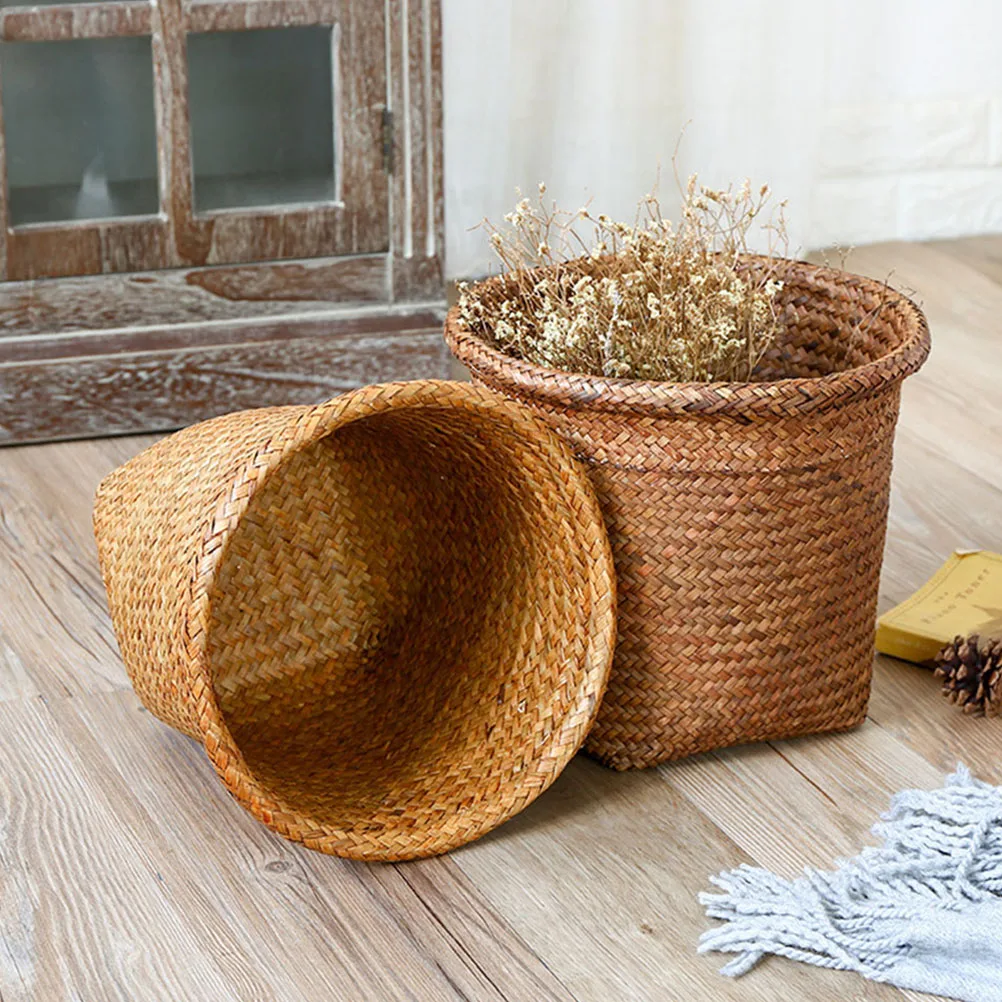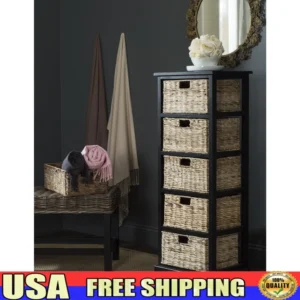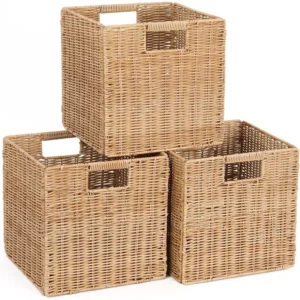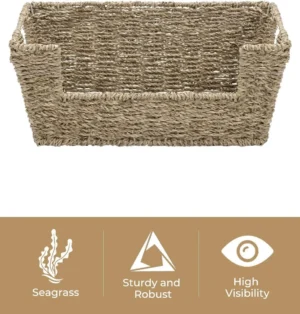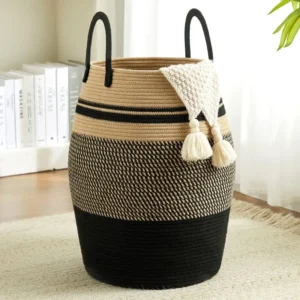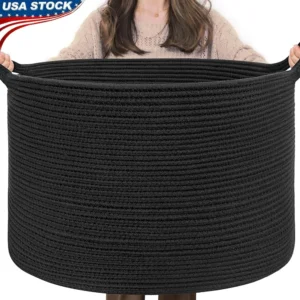Introduction: Understanding the World of Wicker
Wicker refers to a weaving technique rather than a specific material—a common misconception that often confuses first-time buyers. This ancient crafting method involves weaving pliable materials into sturdy, beautiful items like baskets, furniture, and storage solutions. The weaving technique itself dates back thousands of years, with examples found in ancient Egyptian tombs and across numerous historical civilizations.
When shopping for wicker products, you’ll encounter two main categories: natural and synthetic. Each offers distinct advantages and serves different purposes in home organization and décor. Understanding the natural wicker vs synthetic differences becomes crucial when selecting pieces that will both fulfill your storage needs and complement your home’s aesthetic.
The right wicker choice depends on several factors—where you’ll place the item, how you’ll use it, and what environmental conditions it will face. Both natural and synthetic wicker can provide beautiful, functional storage solutions when selected appropriately for their intended use. This guide will help you navigate these choices, understand the unique properties of each type, and determine which best suits your specific home storage and decorative needs.
What is Natural Wicker?
Natural wicker encompasses items woven from plant-based materials harvested directly from nature. These organic materials undergo careful processing—harvested, dried, and sometimes steamed or soaked to achieve the flexibility needed for weaving. The traditional harvesting practices often involve sustainable methods that allow plants to regenerate, maintaining this craft for future generations.
Common natural materials used in wicker weaving include:
- Rattan: A vine-like palm with a solid core and outer skin (peel), both used in weaving
- Willow: Flexible branches known for their strength and traditional appearance
- Bamboo: Sustainable, fast-growing grass with exceptional durability
- Reed: Thin, pliable wetland grass commonly used for basket weaving
- Seagrass: Marine flowering plants with natural water resistance
- Water hyacinth: Aquatic plants with thick stems perfect for sturdy weaving
The construction process for natural wicker items typically involves soaking the materials to enhance pliability, carefully weaving them over frames or forms, and then allowing them to dry into their final shape. Each piece carries the skilled handwork of artisans who understand how to work with the unique properties of these eco-friendly wicker basket materials.
Natural wicker items frequently appear as indoor storage baskets, decorative hampers, and accent pieces—each showcasing the distinct texture, color variations, and character that only natural materials can provide.
Characteristics of Natural Wicker
Natural wicker possesses a distinctive aesthetic charm that’s difficult to replicate. Each piece displays subtle variations in color, texture, and pattern—creating truly unique items that add character to any space. The organic irregularities in the weave create visual interest and depth that mass-produced items simply cannot match.
The tactile experience of natural wicker adds another dimension to its appeal. The fibers have a warm, organic feel with a pleasant texture that’s both sturdy and slightly yielding. This combination of visual and tactile qualities makes natural rattan baskets elevating home aesthetics particularly popular for visible storage in living areas.
One of natural wicker’s functional advantages is its breathability. The small spaces between fibers allow air circulation, which helps prevent mustiness in stored items like clothing or linens. This makes natural wicker excellent for laundry hampers and bedroom storage.
As natural wicker ages, it develops a rich patina that many find increasingly beautiful over time. This aging process adds depth to the color and character to the piece—similar to how fine wood furniture becomes more distinguished with age. The craftsmanship evident in well-made natural wicker items often reflects traditional techniques passed down through generations, with attention to detail in the weaving pattern, edge finishing, and overall structure.
What is Synthetic Wicker?
Synthetic wicker refers to items woven using man-made materials specifically engineered to mimic the appearance and texture of natural fibers while overcoming their limitations. These artificial materials undergo sophisticated manufacturing processes to achieve specific properties like weather resistance, color stability, and durability.
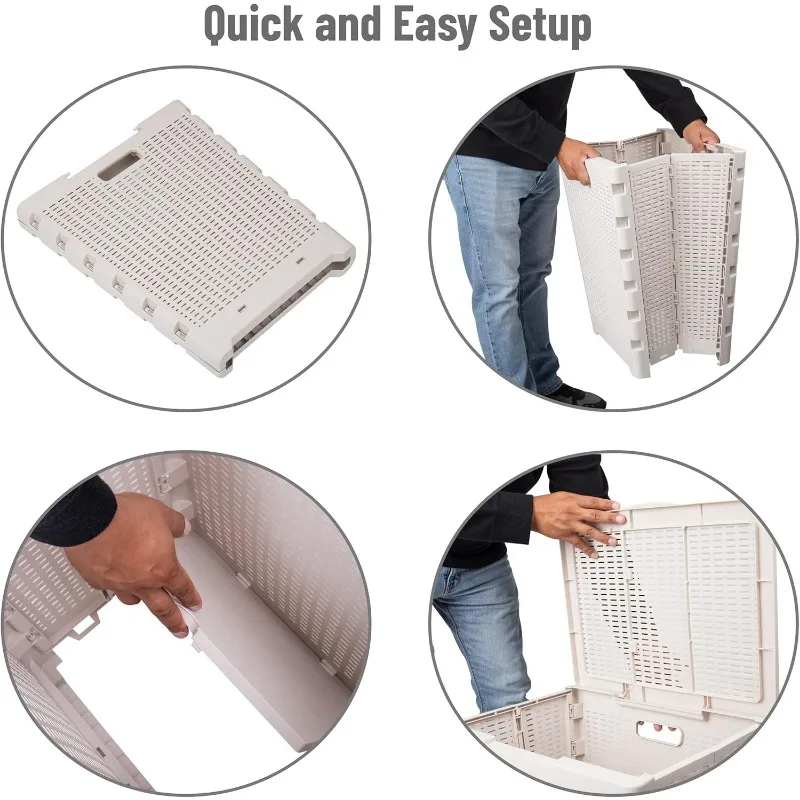
The most common synthetic materials used in modern wicker products include:
- High-Density Polyethylene (HDPE): Premium synthetic fiber with excellent durability and weather resistance
- Regular Polyethylene (PE): Common, cost-effective synthetic with good outdoor performance
- Polyvinyl Chloride (PVC): Rigid synthetic material used in some budget wicker products
- Nylon and other polymers: Specialized synthetics engineered for specific performance characteristics
When shopping, you might see synthetic wicker marketed under various names such as “resin wicker,” “all-weather wicker,” or “faux rattan.” These terms all refer to manufactured materials designed to look like natural wicker while providing enhanced performance characteristics.
The manufacturing process allows engineers to fine-tune specific properties—creating fibers with precise thickness, color, texture, and flexibility. These materials can be formulated to resist UV degradation, repel moisture, and withstand temperature extremes that would quickly damage natural materials. For those concerned about safety in household applications, understanding is synthetic wicker safe for laundry can help with making appropriate choices for specific rooms and functions.
Modern synthetic wicker manufacturing has evolved significantly, with higher-quality products achieving impressively realistic appearances while maintaining their technical advantages over natural materials.
Characteristics of Synthetic Wicker
Synthetic wicker’s most immediately noticeable characteristic is its consistency. Unlike natural materials, synthetic fibers display uniform coloration and identical weaving patterns throughout each piece. This consistency extends to the thickness of strands and the overall appearance, creating a more polished, contemporary look.
The durability of quality synthetic wicker is remarkable—especially against physical stress. These engineered materials resist breaking, splitting, or fraying even with regular use. Their weather resistance represents perhaps their greatest advantage, with high-quality synthetic wicker featuring UV stabilizers that prevent fading and deterioration from sunlight exposure. Additionally, moisture resistance means no warping, mold growth, or rot when exposed to humidity or occasional rain.
Synthetic wicker pieces often weigh more than their natural counterparts and maintain more rigid structures. This added weight and stability makes them ideal for outdoor applications where wind might otherwise be problematic. The synthetic vs natural wicker comparison reveals significant differences in how each material responds to environmental challenges.
The manufacturing process allows for an expanded color palette far beyond natural wicker’s range, including vibrant hues and contemporary neutrals that might better match modern décor schemes. Cleaning synthetic wicker is remarkably straightforward—most pieces can be simply hosed down or wiped clean with mild soap and water, with minimal risk of damage. This ease of maintenance makes synthetic wicker particularly appealing for busy households or areas prone to spills and stains.
Natural vs. Synthetic Wicker: Head-to-Head Comparison
When deciding between natural and synthetic wicker, understanding how they compare across key factors helps make an informed choice for your specific needs. The following comparison highlights the essential differences between these materials:
| Factor | Natural Wicker | Synthetic Wicker |
|---|---|---|
| Material Composition | Plant fibers: rattan, reed, bamboo, willow | Manufactured polymers: HDPE, PE, PVC |
| Durability (Indoor) | Good to excellent with proper care | Excellent |
| Durability (Outdoor) | Poor unless heavily treated | Excellent with UV stabilization |
| Weather Resistance | Limited; susceptible to moisture, sun damage | Excellent; resistant to rain, sun, temperature |
| Maintenance | Regular cleaning, occasional conditioning | Minimal; simple washing as needed |
| Aesthetic Quality | Warm, organic, unique variations | Uniform, consistent, wide color range |
| Initial Cost | Moderate to high for quality pieces | Variable; higher for premium synthetics |
| Long-term Value | Excellent for indoor use | Excellent for outdoor use |
| Environmental Impact | Renewable resources, biodegradable | Petroleum-based, long decomposition time |
| Weight | Typically lighter | Usually heavier, more substantial |
| Ideal Use Cases | Indoor storage, decorative pieces | All-weather outdoor, high-moisture areas |
The key takeaway from this comparison is that neither material is universally “better”—each excels in different applications. Natural wicker brings warmth and character to indoor spaces, while synthetic wicker offers outstanding performance in challenging environments. Many homeowners find that incorporating both types allows them to enjoy the synthetic vs natural wicker guide benefits in the most appropriate settings.
For those seeking storage solutions with various material options, our wicker baskets collection offers diverse choices to match specific needs and preferences.
Durability and Longevity: Which Lasts Longer?
The longevity of wicker items depends significantly on both material type and environmental conditions. Natural and synthetic wicker age very differently, with each having distinct vulnerability factors.
Natural wicker, when used indoors and properly maintained, can last decades—sometimes even becoming family heirlooms. However, several environmental factors dramatically affect its lifespan:
- Sunlight exposure: UV rays break down natural fibers, causing brittleness and fading
- Humidity and moisture: Excess moisture leads to mold, mildew, and fiber deterioration
- Temperature fluctuations: Repeated expansion and contraction weaken fibers over time
- Physical stress: Regular use creates wear at contact points and stress areas
With proper care, quality indoor natural wicker typically lasts 10-20 years. Pieces exposed to adverse conditions may deteriorate within months.
Synthetic wicker offers significantly extended durability, particularly in challenging environments. Premium synthetic wicker with UV stabilizers can maintain its appearance and structural integrity for 5-10 years even with constant outdoor exposure. Indoor synthetic pieces can last decades with minimal care.
Common failure points differ between materials. Natural wicker typically fails at joint connections or develops brittleness from drying out. Synthetic wicker most commonly fails from UV degradation (becoming brittle and faded) or stress cracks at fixed bending points. For storage needs requiring maximum protection, wicker storage baskets with lids provide an extra layer of durability while protecting contents.
Maintenance and Care Requirements
The maintenance requirements for natural and synthetic wicker differ considerably, with natural materials generally requiring more attentive care.
Natural Wicker Care:
* Regular dusting: Use soft brushes or vacuum with brush attachment
* Spot cleaning: Dampen cloth with mild soap solution, wipe gently, dry thoroughly
* Deep cleaning: Annual cleaning with soap and water, minimal moisture, thorough drying
* Conditioning: Occasional linseed oil application to prevent drying (test in inconspicuous area first)
* Storage: Keep in climate-controlled environments away from direct sun
Synthetic Wicker Care:
* Regular cleaning: Dust or hose down as needed
* Stain removal: Most stains wipe away with soap and water
* Seasonal maintenance: Inspect for damage, clean thoroughly once per season for outdoor pieces
* Storage: Optional for most synthetic pieces; covering recommended for extended non-use
Natural wicker requires more frequent maintenance—typically monthly dusting and annual deep cleaning. Synthetic wicker might need attention just seasonally or when visibly soiled. Understanding how to clean wicker baskets properly for each material type helps preserve their appearance and structural integrity.
For restoration, natural wicker sometimes allows for minor repairs through rewrapping or splinting damaged sections. Synthetic wicker rarely can be repaired once structural damage occurs, though surface cleaning can often restore appearance even after significant neglect.
Aesthetics and Design Versatility
The aesthetic qualities of natural and synthetic wicker contribute significantly to their role in interior and exterior design, with each offering distinct visual contributions to your space.
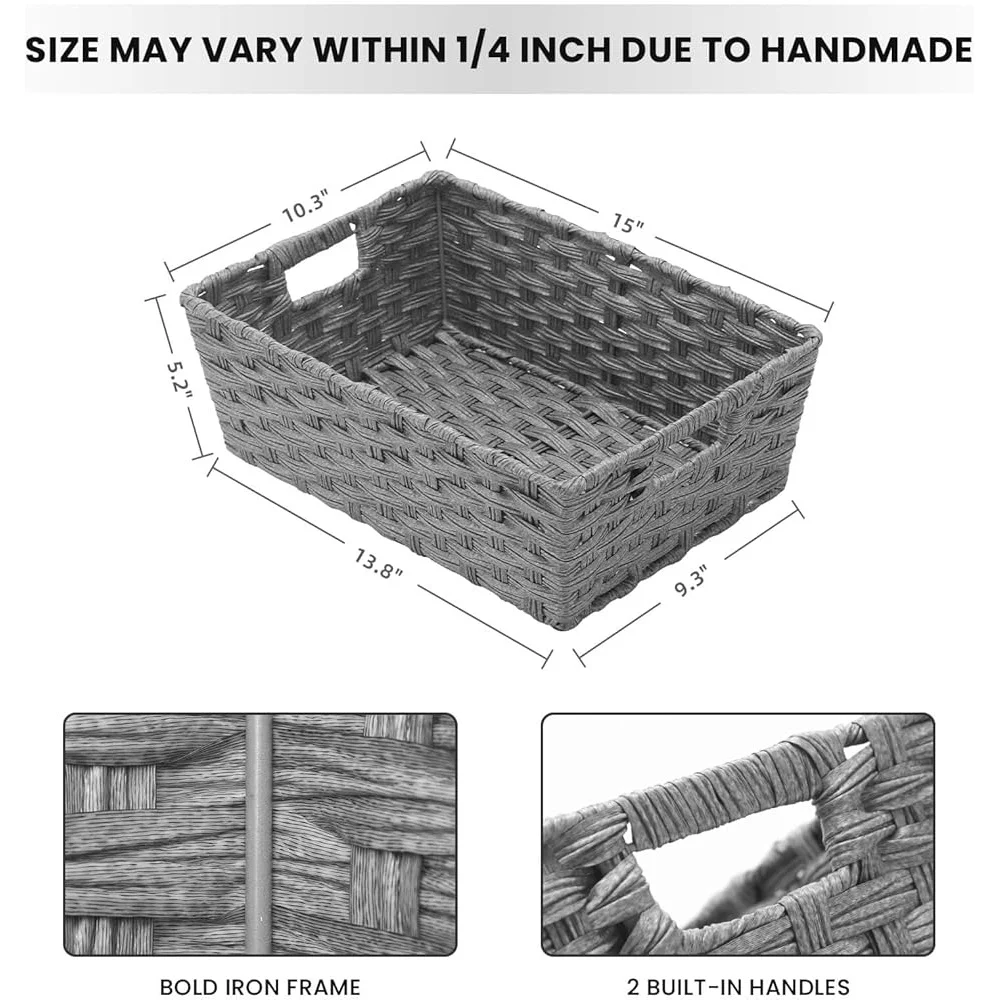
Natural wicker brings organic warmth through its variations in color, texture, and pattern. These subtle irregularities create visual interest and depth, with each piece having a unique character. The natural tones—ranging from pale blonds to rich ambers and deep browns—provide neutral versatility that complements numerous design styles. The material particularly excels in:
- Bohemian and eclectic interiors, adding textural elements
- Coastal and beach-inspired designs, evoking relaxed natural environments
- Rustic and farmhouse styles, complementing other natural materials
- Traditional settings, reflecting classic craftsmanship
Synthetic wicker offers precision and consistency with perfect weave patterns and uniform coloration. This controlled appearance creates a more contemporary, polished look that suits modern design aesthetics. The expanded color palette—including options impossible with natural materials—allows for creative design integration beyond what natural wicker permits.
Both materials add important textural elements to spaces that might otherwise feel flat or one-dimensional. For practical storage solutions that also enhance your décor, our wicker storage baskets collection offers options in various materials to match different design preferences.
Cost Analysis: Initial Investment vs. Long-Term Value
The price difference between natural and synthetic wicker reflects both material costs and manufacturing complexities, with several factors influencing the overall value proposition.
Natural wicker typically has these cost considerations:
- Higher labor costs due to skilled handcraft requirements
- Material quality variations affecting price (premium rattan commands higher prices)
- Craftsmanship level significantly impacting cost
- Traditional techniques requiring more time than machine production
Synthetic wicker pricing varies based on:
- Polymer quality (premium HDPE costs more than basic PE or PVC)
- Manufacturing precision and weave complexity
- UV inhibitor and color stabilizer inclusion
- Brand reputation and warranty offerings
When considering long-term value, factor in:
- Replacement frequency based on use environment
- Maintenance products and time investment
- Versatility across seasons and settings
- Potential repair costs over ownership
Quality indicators for natural wicker include tight, consistent weaving, smooth fiber finishes, and sturdy construction. For synthetic wicker, look for UV-resistance guarantees, color-through construction (not surface-painted), and appropriate weight for the size. The natural vs synthetic wicker laundry comparison highlights how these cost considerations play out in specific applications.
While premium synthetic wicker may have a higher initial cost, its extended lifespan in challenging environments often provides better value for outdoor applications. Conversely, quality natural wicker offers excellent indoor longevity with proper care, potentially lasting generations.
Black Wicker Baskets, Rattan Storage Baskets, Tall Wicker Baskets, Wicker Shelf Baskets, Woven Storage Baskets
5-Tier Distressed Black Wood Frame Storage Tower with Removable Wicker Baskets for Home Organization$715.80 Select options This product has multiple variants. The options may be chosen on the product pageWicker Laundry Baskets, Woven Laundry Baskets, Woven Storage Baskets
$392.02 Select options This product has multiple variants. The options may be chosen on the product pageRattan Shelf Baskets, Rattan Storage Baskets, Small Wicker Baskets, Square Wicker Baskets
Square Plastic Wicker Storage Baskets Set of 3 with Collapsible Design for Cube Storage Organization$185.47 Select options This product has multiple variants. The options may be chosen on the product pageWicker Baskets with Handles, Wicker Storage Baskets, Woven Storage Baskets
$137.92 Select options This product has multiple variants. The options may be chosen on the product pageLarge Wicker Laundry Baskets, Tall Wicker Baskets, Woven Laundry Hampers, Woven Storage Baskets
$130.54 Select options This product has multiple variants. The options may be chosen on the product pageWicker Blanket Baskets, Woven Laundry Baskets
$89.60 Select options This product has multiple variants. The options may be chosen on the product page
Environmental Impact and Sustainability
The environmental profiles of natural and synthetic wicker present different considerations for environmentally conscious consumers.
Natural wicker materials offer several environmental advantages:
- Renewable resource potential when properly harvested
- Biodegradability at end of product life
- Lower energy manufacturing processes
- Carbon sequestration during plant growth
However, natural materials also raise concerns:
- Potential habitat disruption without sustainable harvesting
- Transportation impacts from exotic source locations
- Chemical treatments sometimes used in processing
Synthetic wicker presents a different environmental profile:
- Petroleum-based raw materials (non-renewable resource)
- Energy-intensive manufacturing processes
- Extended decomposition timeframe (hundreds of years)
- Potential for microplastic shedding as products degrade
Recent innovations have improved the environmental profile of both materials. Sustainable harvesting certification programs now monitor natural material sourcing, while some synthetic wicker now incorporates recycled plastics or offers take-back recycling programs. Several manufacturers now produce HDPE wicker from recycled ocean plastics or post-consumer waste.
Product longevity represents an important sustainability factor often overlooked. Durable products that don’t require frequent replacement reduce overall resource consumption regardless of material type. For those prioritizing natural materials, our rattan baskets collection showcases the beauty of responsibly sourced natural fibers.
Where to Use Natural Wicker: Ideal Applications
Natural wicker finds its ideal application in protected indoor environments where its aesthetic qualities and breathability provide both functional and decorative benefits.
Optimal indoor uses include:
- Living rooms: Magazine storage, decorative catch-all baskets, media organization
- Bedrooms: Clothing hampers, blanket storage, under-bed organization boxes
- Bathrooms: Toiletry organization, towel storage (in moderate humidity only)
- Home offices: Paper management, supply corralling, decorative waste baskets
Natural wicker can work in protected outdoor settings with these limitations:
* Covered porches well-sheltered from direct elements
* Seasonal use with proper indoor storage during harsh weather
* Regular application of protective sealants (though effectiveness is limited)
Natural wicker particularly enhances design schemes emphasizing organic materials, textural variety, and craftsmanship. The material adds warmth to contemporary spaces that might otherwise feel sterile and brings authenticity to traditional or global-inspired interiors.
When using natural wicker in bathrooms or humid areas, ensure adequate ventilation to prevent mildew growth. Position pieces away from direct sunlight streaming through windows to prevent UV damage and fiber brittleness. With proper placement and care, natural wicker brings unmatched character and texture to your home organization systems.
Where to Use Synthetic Wicker: Ideal Applications
Synthetic wicker excels in environments where durability against the elements is essential, making it the superior choice for numerous challenging settings.
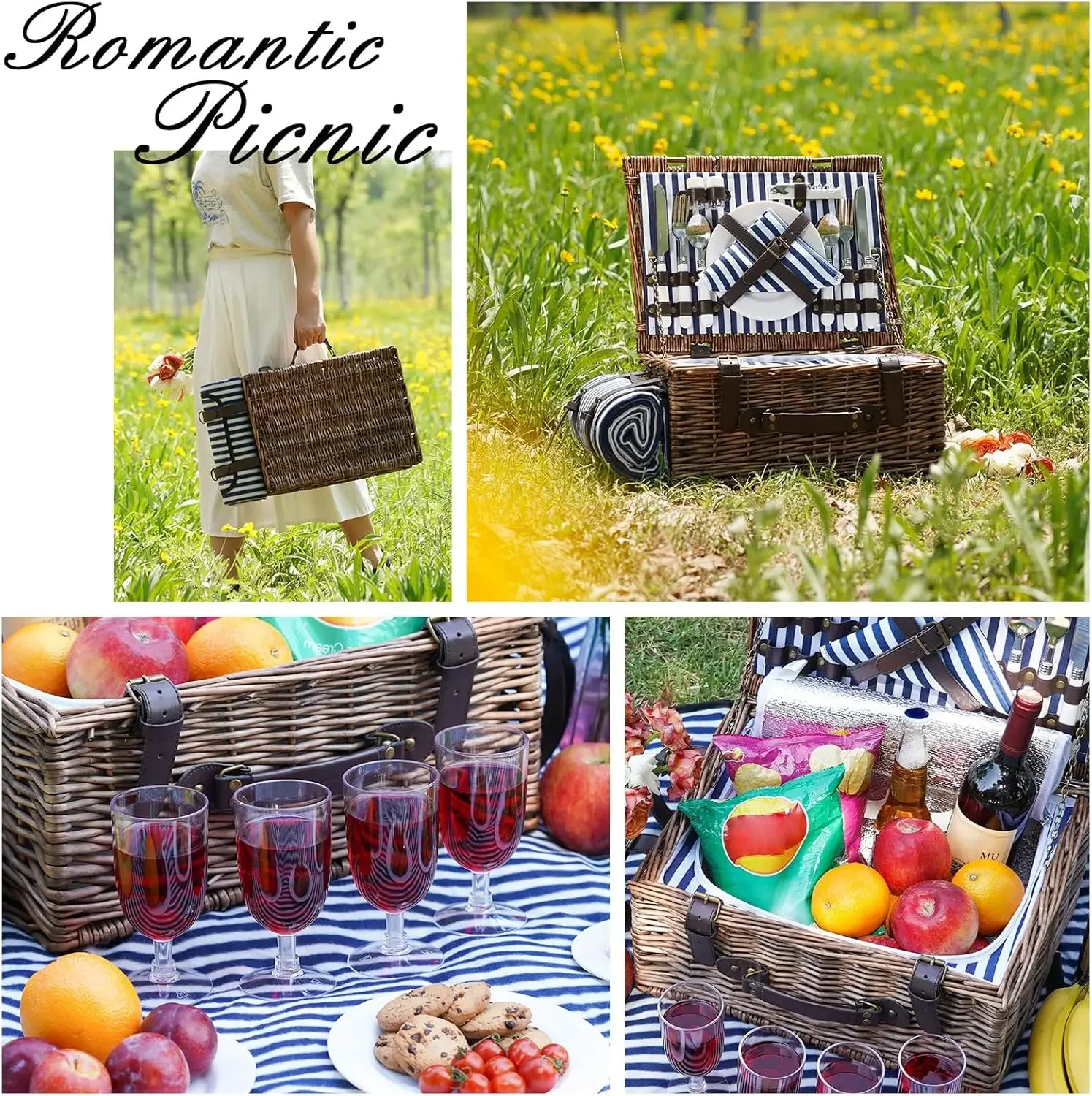
Optimal outdoor applications include:
- Exposed patios and decks: Storage boxes, planters, accessory containers
- Pool areas: Towel hampers, equipment storage, poolside organization
- Garden settings: Tool organization, outdoor toy storage, cushion storage
- Year-round exterior use: Any storage exposed to weather fluctuations
Inside the home, synthetic wicker proves valuable in challenging environments:
- High-humidity bathrooms: Toiletry organization, hampers in shower-adjacent areas
- Sunrooms with direct UV exposure: Plant stands, magazine storage, hobby supplies
- Basements with moisture concerns: Seasonal storage, game organization, utility needs
Synthetic wicker complements contemporary design schemes, transitional spaces, and outdoor living areas designed as extensions of indoor rooms. Its consistent appearance and expanded color options allow for precise matching to color schemes and design themes.
For outdoor dining and recreation, wicker picnic baskets made from weather-resistant synthetic materials provide both functionality and style without concern about weather damage.
When maximum durability matters most—especially for items regularly exposed to moisture, sunlight, or temperature fluctuations—synthetic wicker provides peace of mind along with attractive organization solutions.
How to Identify Quality Wicker (Both Types)
Recognizing quality wicker requires attention to specific details regardless of material type, with some universal indicators and some material-specific signs to evaluate.
Universal quality indicators include:
- Weave consistency and tightness: Even spacing without gaps or irregularities
- Frame construction: Solid, non-wobbly structure with reinforced stress points
- Weight appropriate to type: Substantial feel without being excessively heavy
- Finish quality: Smooth surfaces without rough edges or splinters
For natural wicker, look specifically for:
- Fiber quality and uniformity: Consistent diameter strands without weak spots
- Natural color consistency: Even coloration appropriate to the material type
- Smooth fiber surfaces: No splintering, cracking, or rough patches
- Tight joinery: Where elements connect, weaving should be particularly secure
For synthetic wicker, quality indicators include:
- UV resistance claims: Look for specific UV inhibitor information
- Colorfastness guarantees: Better products offer color warranties
- Flexibility without cracking: When gently flexed, quality synthetic wicker bends slightly without stress marks
- Thickness of synthetic fibers: Thicker strands generally indicate higher quality
Understanding the difference between materials is essential—our guide on natural vs synthetic rattan helps identify authentic materials versus imitations. Quality pieces of either type should feel sturdy, with tight construction and attention to detail in finishing edges and connection points.
When examining wicker items, run your hand along surfaces to feel for rough spots or inconsistencies. Gently press on various areas to test structural integrity. Quality pieces maintain consistent construction throughout, not just in visible areas.
Is Synthetic Wicker Really Maintenance-Free?
Despite marketing claims about “maintenance-free” synthetic wicker, these products still require some care to maintain their appearance and longevity. While synthetic wicker certainly demands less attention than natural materials, calling it completely maintenance-free overstates reality.
Even high-quality synthetic wicker needs:
- Regular cleaning to remove environmental debris like pollen, dust, and bird droppings
- Occasional deeper cleaning to address built-up grime in weave intersections
- Attention to frame components (especially if metal frames are involved)
- Protection from extreme conditions like hail or freezing temperatures
Environmental pollutants can be particularly problematic—tree sap, bird droppings, and industrial pollutants can cause staining if left untreated. Most synthetic wicker benefits from seasonal cleaning with mild soap and water, followed by thorough rinsing.
While “all-weather” is a more accurate description than “maintenance-free,” synthetic wicker does offer dramatically reduced maintenance requirements compared to natural materials. Where natural wicker might require monthly attention, quality synthetic pieces might need only quarterly or seasonal care to maintain their appearance.
The most significant maintenance advantage comes from synthetic wicker’s ability to withstand direct water exposure during cleaning—allowing for simple hosing off rather than the careful spot-cleaning required for natural materials.
Can Natural Wicker Ever Be Used Outdoors?
Natural wicker can survive in limited outdoor applications with proper precautions and realistic expectations. While not ideal for constant exterior exposure, natural wicker can work in protected outdoor settings with specific conditions.
Suitable outdoor applications for natural wicker include:
- Fully covered porches or patios with protection from direct rain
- Seasonal use with appropriate storage during off-seasons or inclement weather
- Areas with minimal UV exposure and moderate humidity levels
Protective measures that extend outdoor usability include:
- Applying marine-grade sealants or specialized outdoor varnishes (though these alter appearance)
- Using protective furniture covers when not in use
- Positioning pieces away from direct sun and moisture sources
- Regular reapplication of protective treatments
Even with these precautions, natural wicker used outdoors will have a significantly shorter lifespan than when used indoors. Most natural wicker will show signs of weather damage within one to two seasons of outdoor exposure—including color fading, fiber splitting, and structural weakening.
Some natural materials perform better outdoors than others. Certain types of rattan and bamboo offer marginally better weather resistance, while water hyacinth has some natural moisture resistance. However, all will eventually degrade without proper protection.
Warning signs indicating weather damage include discoloration, brittleness, mold spots, and loosening of the weave pattern. When these appear, moving the piece indoors can sometimes halt further deterioration.
How to Choose Between Natural and Synthetic for Your Specific Needs
Making the right choice between natural and synthetic wicker depends on carefully evaluating your specific circumstances and priorities. Consider these key decision factors:
Placement environment:
* Indoor with controlled climate → Natural wicker excels
* Outdoor or high-moisture indoor areas → Synthetic wicker recommended
* Mixed-use or transitional spaces → Consider synthetic for versatilityClimate and environmental conditions:
* Humid regions → Synthetic offers better mold resistance
* Dry climates → Natural may require conditioning to prevent brittleness
* High-UV exposure areas → Synthetic with UV inhibitors performs betterAesthetic preferences:
* Organic, warm, variable appearance → Natural wicker
* Consistent, precise, contemporary look → Synthetic wicker
* Traditional design context → Natural often better complementsBudget considerations:
* Limited initial budget for indoor use → Quality natural might be affordable
* Investment in long-term outdoor pieces → Premium synthetic offers better value
* Frequent design changes → Less expensive options of either typeMaintenance willingness:
* Minimal maintenance desired → Synthetic wicker
* Willing to perform regular care → Natural wicker can be rewarding
* Mixed maintenance capacity → Reserve natural for special pieces
For many homes, a hybrid approach works best—using synthetic wicker in challenging environments and natural wicker where its aesthetic qualities can shine without exposure to damaging elements. This strategic placement maximizes the advantages of both materials while minimizing their drawbacks.
The choice between synthetic and natural wicker ultimately comes down to aligning your specific needs with the inherent properties of each material. By understanding these differences, you can select pieces that will provide both beauty and function for years to come.
At Tidy Treasure, we offer both natural and synthetic wicker options to meet various needs, helping you organize your home beautifully with the right material for each space and purpose.

